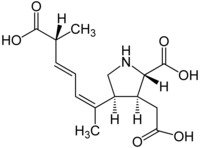Domoic acid

| |
| Identifiers | |
|---|---|
3D model (JSmol)
|
|
| ChEMBL | |
| ChemSpider | |
| ECHA InfoCard | 100.159.099 |
PubChem CID
|
|
CompTox Dashboard (EPA)
|
|
| |
| |
| Properties | |
| C15H21NO6 | |
| Molar mass | 311.3303 g/mol |
| Density | 1.273 g/cm3 |
| Boiling point | 607.2 degrees Celsius at 760 mmHg (101.3 kPa) |
| Vapor pressure | 2.62×10−16 mmHg (34.9 fPa) at 25 °C |
| Hazards | |
| Flash point | 321°C |
Except where otherwise noted, data are given for materials in their standard state (at 25 °C [77 °F], 100 kPa).
| |
Domoic acid (DA), the neurotoxin that causes amnesic shellfish poisoning (ASP), is a kainic acid analog, heterocyclic amino acid associated with certain harmful algal blooms.[1]
Occurrence
In 1958, domoic acid was originally isolated from the red alga called "doumoi" or "hanayanagi" (Chondria armata[2]) in Japan. "Doumoi" is used as an anthelmintic in Tokunoshima, Kagoshima.[3] Domoic acid is also produced by some diatoms of the genus Pseudo-nitzschia[1] and by some strains of the diatom species Nitzschia navis-varingica[4].[1]
Pseudo-nitzschia multiseries loses most of its ability to produce domoic acid when it is cultured axenically. However, domoic acid production recovers when bacteria from the original culture are reintroduced to axenic cultures, indicating a bacterial association with domoic acid production in this species.[5] Other factors that affect the biosynthesis of domoic acid are reviewed by Bates and Trainer (2006) [6], Trainer et al. (2008) [7], Lelong et al. (2012) [8] and Trainer et al. (2012) [9].
The increasing frequency and geographic extent of toxic algal blooms along populated coastlines is generally attributed to human activities.[10]
Chemistry
This section needs expansion. You can help by adding to it. (June 2008) |
Domoic acid is a structural analog of kainic acid and proline. General aspects of domoic acid chemistry, including its isomers and degradation, are reviewed by Lelong et al. (2012) [11].
Toxicology
Considerable recent research has been carried out by the Marine Mammal Center and other scientific centers on the association of domoic acid-producing harmful algal blooms and neurological damage in marine mammals of the Pacific Ocean.
Domoic acid can bioaccumulate in marine organisms such as shellfish, anchovies, and sardines that feed on the phytoplankton known to produce this toxin. DA can accumulate in high concentrations in the tissues of these plankton feeders when the toxic phytoplankton itself is high in concentration in the surrounding waters.
In mammals, including humans, domoic acid acts as a neurotoxin, causing short-term memory loss, brain damage and, in severe cases, death. DA-producing algal blooms are associated with the phenomenon of amnesic shellfish poisoning (ASP). In marine mammals, domoic acid typically causes seizures and tremors. In the brain, domoic acid especially damages the hippocampus and amygdaloid nucleus. It damages the neurons by activating AMPA and kainate receptors, causing an influx of calcium. Although calcium flowing into cells is a normal event, the uncontrolled increase of calcium causes the cell to degenerate. Because the hippocampus may be severely damaged, short-term memory loss occurs.
See also
References
- ^ a b c "Domoic Acid and Pseudo-nitzschia References". Fisheries and Oceans Canada. 2012-03-15. Retrieved 2012-04-08.
- ^ Guiry, M. D.; Guiry, G. M. (2012). "Chondria armata (Kützing) Okamura". AlgaeBase. National University of Ireland. Retrieved 2012-04-08.
{{cite web}}: CS1 maint: multiple names: authors list (link) - ^ Ramsdell, J. S. (2007). "The Molecular and Integrative Basis to Domoic Acid Toxicity". In Botana, L. M. (ed.). Phycotoxins: Chemistry and Biochemistry. Wiley-Blackwell. p. 244. doi:10.1002/9780470277874.ch13. ISBN 0-8138-2700-0.
- ^ "Nitzschia navis-varingica Lundholm & Moestrup, 2000". HABs taxon details. Marine Species.
- ^ Kobayashi, K.; Takata, Y.; Kodama, M. (2009). "Direct contact between Pseudo-nitzschia multiseries and bacteria is necessary for the diatom to produce a high level of domoic acid" (pdf). Fisheries Science. 75 (3): 771–776. doi:10.1007/s12562-009-0081-5.
{{cite journal}}: CS1 maint: multiple names: authors list (link) - ^ Bates, S.S. and V.L. Trainer. 2006. The ecology of harmful diatoms. In: E. Granéli an d J. Turner [eds.] Ecology of harmful algae. Ecological Studies, Vol. 189. Springer-Verlag, Heidelberg, p. 81-93. PDF; 181 KB
- ^ Trainer, V.L., B.M. Hickey, and S.S. Bates. 2008. Toxic diatoms. In: P.J. Walsh, S.L. Smith, L.E. Fleming, H. Solo-Gabriele, and W.H. Gerwick [eds.], Oceans and human health: risks and remedies from the sea. Elsevier Science Publishers, New York, p. 219-237. PDF 2.7 MB
- ^ Lelong, A., H. Hégaret, P. Soudant, and S.S. Bates. 2012. Pseudo-nitzschia (Bacillariophyceae) species, domoic acid and amnesic shellfish poisoning: revisiting previous paradigms. Phycologia 51: 168-216. PDF; 1.8 MB
- ^ Trainer, V.L., S.S. Bates, N. Lundholm, A.E. Thessen, W.P. Cochlan, N.G. Adams, and C.G. Trick. 2012. Pseudo-nitzschia physiological ecology, phylogeny, toxicity, monitoring and impacts on ecosystem health. Harmful Algae 14: 271–300. Publisher's abstract and link to PDF file
- ^ Silver, M. W.; Bargu, S.; Coale, S. L.; Benitez-Nelson, C. R.; Garcia, A. C.; Roberts, K. J.; Sekula-Wood, E.; Bruland, K. W.; Coale, K. H. (2010). "Toxic diatoms and domoic acid in natural and iron enriched waters of the oceanic Pacific" (pdf). PNAS. 107 (48): 20762–20767. doi:10.1073/pnas.1006968107.
{{cite journal}}: CS1 maint: multiple names: authors list (link) - ^ Lelong, A., H. Hégaret, P. Soudant, and S.S. Bates. 2012. Pseudo-nitzschia (Bacillariophyceae) species, domoic acid and amnesic shellfish poisoning: revisiting previous paradigms. Phycologia 51: 168-216. PDF; 1.8 MB
External links
- "Domoic Acid and Pseudo-nitzschia References". Fisheries and Oceans Canada.
- "Amnesic Shellfish Poisoning, Domoic Acid, and Pseudo-nitzschia". International Society for the Study of Harmful Algae ISSHA.
- "Domoic acid". IPCS INCHEM.
- "Domoic Acid - A Major Concern to Washington State's Shellfish Lovers". Washington Department of Fish and Wildlife.
